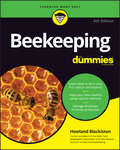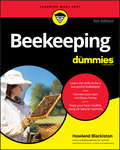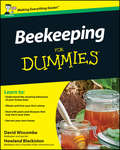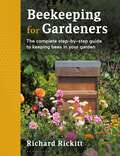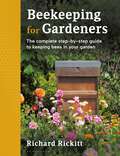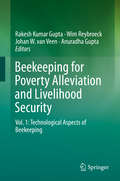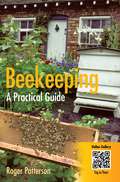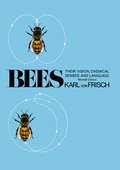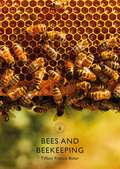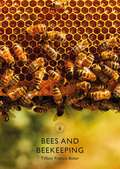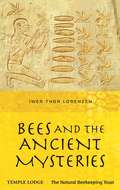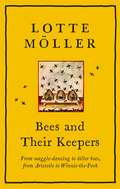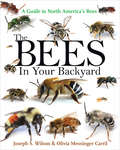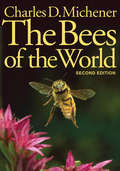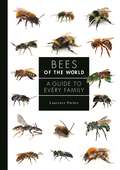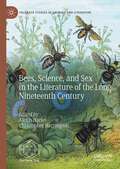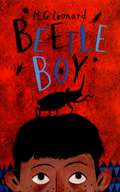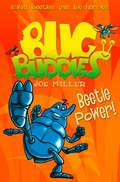- Table View
- List View
Beekeeping For Dummies
by Howland BlackistonEverything you need to 'bee' a successful backyard beekeeper If you've ever thought about becoming a backyard beekeeper—or have already tried a hand at it and want to be better one—then this is the book for you! In Beekeeping for Dummies, 4th Edition you'll find everything you need to know in order to start your own colony, including how to assemble and maintain beehives, handle every phase of honey production, purchase and use all the latest tools, and what to do beyond your first season. This hands-on guide provides all the tools, tips, tricks, and techniques needed to become a real backyard beekeeper. You'll learn to identify the queen from her workers and drones, properly open and close the hive, distinguish one type of honey from another, and preserve your colony if disaster should strike. Keep bees on a small urban rooftop or in a large country yard Assemble your own hive and sustain it for years to come Safely inspect and manage your colony Harvest and sell your own honey Becoming a backyard beekeeper isn't as hard as people think—and with this hands-on guide, you'll be able to create one honey of a colony that will have the neighbors buzzing.
Beekeeping For Dummies: 4th Edition
by Howland BlackistonThe single best and most comprehensive guide for prospective, new and experienced hobbyist beekeepers Beekeeping For Dummies, 5th Edition, is one of the most popular titles in the For Dummies series available today. Including the latest information regarding every aspect of backyard beekeeping and honey production, this book describes how to get started, how to care for and safely handle bees, and how to maintain healthy and productive colonies. This book is loaded with up-to-date, practical examples and helpful illustrations of proven techniques and strategies for both new and seasoned hobbyist beekeepers. Some of the updates for this brand-new edition include: New information regarding the critical role that nutrition plays in the health and productivity of your bees News about the latest beekeeping products, medications, and all-natural remedies Information regarding dozens of helpful beekeeping resources Redeemable coupons from beekeeping suppliers that save the reader money Beekeeping For Dummies embodies the straightforward and simple approach made famous by the For Dummies series. Each and every reader will benefit from its accessible and approachable take on beekeeping.
Beekeeping For Dummies
by Howland BlackistonThe single best and most comprehensive guide for prospective, new and experienced hobbyist beekeepers Beekeeping For Dummies, 5th Edition, is one of the most popular titles in the For Dummies series available today. Including the latest information regarding every aspect of backyard beekeeping and honey production, this book describes how to get started, how to care for and safely handle bees, and how to maintain healthy and productive colonies. This book is loaded with up-to-date, practical examples and helpful illustrations of proven techniques and strategies for both new and seasoned hobbyist beekeepers. Some of the updates for this brand-new edition include: New information regarding the critical role that nutrition plays in the health and productivity of your bees News about the latest beekeeping products, medications, and all-natural remedies Information regarding dozens of helpful beekeeping resources Redeemable coupons from beekeeping suppliers that save the reader money Beekeeping For Dummies embodies the straightforward and simple approach made famous by the For Dummies series. Each and every reader will benefit from its accessible and approachable take on beekeeping.
Beekeeping For Dummies: 4th Edition
by David Wiscombe Howland BlackistonThe fast and easy way to start and maintain a hive Beekeeping For Dummies is a practical, step-by-step beginner's guide to beekeeping. It gives you plain-English guidance on everything you need to know to start your own beehive, from buying the right equipment, sourcing bees, and locating your hive to maintaining a healthy colony and harvesting honey. Plus, you'll get the latest information on the causes and effects of bee disease, colony collapse disorder, and the impact the sudden disappearance of the honeybee has on our environment and economy. Here, you'll get trusted information on beekeeping in the UK, specifically written to address climate, buying equipment, locating hives, the local impact of colony collapse disorder and ways to avoid or minimise the risk to your hive, seasonal beekeeping tasks, local beekeeping associations, and updated content on urban beekeeping. Understand the anatomy of your bees Learn techniques and tips for harvesting, bottling, packaging, and selling honey Discover the benefits of beekeeping Learn techniques on obtaining and hiving your bees If you're a beginner beekeeper, taking a beekeeping course, or just have an interest in the plight of the honeybee, Beekeeping For Dummies has you covered!
Beekeeping For Dummies
by David Wiscombe Howland BlackistonThe fast and easy way to start and maintain a hive Beekeeping For Dummies is a practical, step-by-step beginner's guide to beekeeping. It gives you plain-English guidance on everything you need to know to start your own beehive, from buying the right equipment, sourcing bees, and locating your hive to maintaining a healthy colony and harvesting honey. Plus, you'll get the latest information on the causes and effects of bee disease, colony collapse disorder, and the impact the sudden disappearance of the honeybee has on our environment and economy. Here, you'll get trusted information on beekeeping in the UK, specifically written to address climate, buying equipment, locating hives, the local impact of colony collapse disorder and ways to avoid or minimise the risk to your hive, seasonal beekeeping tasks, local beekeeping associations, and updated content on urban beekeeping. Understand the anatomy of your bees Learn techniques and tips for harvesting, bottling, packaging, and selling honey Discover the benefits of beekeeping Learn techniques on obtaining and hiving your bees If you're a beginner beekeeper, taking a beekeeping course, or just have an interest in the plight of the honeybee, Beekeeping For Dummies has you covered!
Beekeeping for Gardeners: The complete step-by-step guide to keeping bees in your garden
by Richard RickittA comprehensive gardener's guide to sustainable beekeeping.Beekeeping has changed. While once it was a hobby that pursued the rich rewards of honey and wax, many new beekeepers now instead seek the gratification of knowing that they are aiding the survival of one of the world's most important creatures. Keeping bees today is as much about providing the right habitats and resources to help pollinators thrive as it is about chasing every drop of golden honey.This beautifully illustrated guide to the ancient hobby of beekeeping shows today's gardeners how to create beautiful gardens that are richly rewarding for people and bees alike. Flowers, shrubs, trees and vegetable plots can provide colourful beauty and delicious produce as well as vital pollen and nectar when bees need it the most. There are lists of the top-performing plants and how and where to grow them, including window boxes, lawns, borders, wild gardens and even ponds.Beekeeping for Gardeners looks at the pleasures and benefits of keeping honey bees in gardens of all types and sizes, both rural and urban. It explains the practicalities involved in keeping bees in the domestic garden setting, as well as on rooftops, allotments, parks, farmland and other locations. Importantly, and unlike any book before, this guide sets the delightful hobby of beekeeping within the context of the wider environment, asking how it can best serve the needs of all types of pollinator and the local ecology in general.Whether you're looking to attract more bumblebees and solitary bees or want to install a beehive, this wonderful book contains all the guidance you'll need to have a garden buzzing with bees.
Beekeeping for Gardeners: The complete step-by-step guide to keeping bees in your garden
by Richard RickittA comprehensive gardener's guide to sustainable beekeeping.Beekeeping has changed. While once it was a hobby that pursued the rich rewards of honey and wax, many new beekeepers now instead seek the gratification of knowing that they are aiding the survival of one of the world's most important creatures. Keeping bees today is as much about providing the right habitats and resources to help pollinators thrive as it is about chasing every drop of golden honey.This beautifully illustrated guide to the ancient hobby of beekeeping shows today's gardeners how to create beautiful gardens that are richly rewarding for people and bees alike. Flowers, shrubs, trees and vegetable plots can provide colourful beauty and delicious produce as well as vital pollen and nectar when bees need it the most. There are lists of the top-performing plants and how and where to grow them, including window boxes, lawns, borders, wild gardens and even ponds.Beekeeping for Gardeners looks at the pleasures and benefits of keeping honey bees in gardens of all types and sizes, both rural and urban. It explains the practicalities involved in keeping bees in the domestic garden setting, as well as on rooftops, allotments, parks, farmland and other locations. Importantly, and unlike any book before, this guide sets the delightful hobby of beekeeping within the context of the wider environment, asking how it can best serve the needs of all types of pollinator and the local ecology in general.Whether you're looking to attract more bumblebees and solitary bees or want to install a beehive, this wonderful book contains all the guidance you'll need to have a garden buzzing with bees.
Beekeeping for Poverty Alleviation and Livelihood Security: Vol. 1: Technological Aspects of Beekeeping
by Rakesh Kumar Gupta Wim Reybroeck Johan W. Veen Anuradha GuptaThis Book intends to address all aspects needed to develop beekeeping into a powerful instrument of rural development and will focus on beekeeping as a tool for Poverty Alleviation and Livelihood security. In the backdrop of the social and economic issues of the people living in poverty region, the book aims to delineate specific motivation approaches to engage them in beekeeping and will serve as a guide for effective marketing through diversification and value addition of bee products. Nevertheless, marketing and environmental issues will remain an important component of this book. The aim is also to focus on indirect benefit of beekeeping so that it is integrated with farming and nature conservation. Other topics include ensuring the provision of practical techniques in handling and management of bees. It will provide detailed information on good contacts with policymakers and authorities; and channels for attracting finance especially in the third world countries. An interdisciplinary approach is the key feature of the book and it will also focus on few case histories and success stories to encourage the reader to take up beekeeping as a new venture gradually in a phased manner like traditional-transitional and modernised beekeeping. With the publication of this book, we hope to hand out a practical guide that will assist all those who are involved in beekeeping for development. We hope it will stimulate beekeeping as an integrated activity with farming and nature conservation and will serve in many households for poverty alleviation and livelihood security.
Beekeeping - A Practical Guide: A Practical Guide
by Roger PattersonA practical book for new beekeepers and those interested in keeping their own bees, explaining everything they need to know to get started. It also covers how to make your garden attractive for bees. Published to coincide with the biggest beginners' day for beekeeping which takes place in February each year.
Bees: Their Vision, Chemical Senses, and Language
by Karl von FrischOver half a century of brilliant scientific detective work, the Nobel Prize-winning biologist Karl von Frisch learned how the world, looks, smells, and tastes to a bee. More significantly, he discovered their dance language and their ability to use the sun as a compass. Intended to serve as an accessible introduction to one of the most fascinating areas of biology, Bees (first published in 1950 and revised in 1971), reported the startling results of his ingenious and revolutionary experiments with honeybees. In his revisions, von Frisch updated his discussion about the phylogenetic origin of the language of bees and also demonstrated that their color sense is greater than had been thought previously. He also took into consideration the electrophysiological experiments and electromicroscopic observations that have supplied more information on how the bee analyzes polarized light to orient itself and how the olfactory organs on the bee's antennae function. Now back in print after more than two decades, this classic and still-accurate account of the behavior patterns and sensory capacities of the honeybee remains a book "written with a simplicity, directness, and charm which all who know him will recognize as characteristic of its author. Any intelligent reader, without scientific training, can enjoy it."—Yale Review
Bees and Beekeeping (Shire Library)
by Tiffany Francis-BakerBees existed long before human beings, but our future is perhaps more reliant upon them than any other species. They pollinate 80 per cent of the world's crops and plants, but how much do we really know about them? Small, clever and mysterious, the honeybee in particular has long been celebrated in human culture as a sacred insect, a symbol of the sun, bridging the gap between our world and the next. They are expert communicators, skilled aviators and natural alchemists, turning fresh nectar into sweet, golden honey. They are also in trouble and need our help. This beautifully illustrated guide explores the honeybee's historic relationship with humans, the basics of beekeeping, and how we can help save the bees' dwindling population.
Bees and Beekeeping (Shire Library)
by Tiffany Francis-BakerBees existed long before human beings, but our future is perhaps more reliant upon them than any other species. They pollinate 80 per cent of the world's crops and plants, but how much do we really know about them? Small, clever and mysterious, the honeybee in particular has long been celebrated in human culture as a sacred insect, a symbol of the sun, bridging the gap between our world and the next. They are expert communicators, skilled aviators and natural alchemists, turning fresh nectar into sweet, golden honey. They are also in trouble and need our help. This beautifully illustrated guide explores the honeybee's historic relationship with humans, the basics of beekeeping, and how we can help save the bees' dwindling population.
Bees and the Ancient Mysteries
by Iwer Thor LorenzenIn an extraordinary exposition, Lorenzen – an expert beekeeper and student of contemporary spiritual science – describes the ‘Logos mysteries’, based at the ancient temple of Artemis in Ephesus, where priestesses were known as ‘Melissas’ (‘honeybees’) and the sacrificial priests were called ‘Essenes’ (or ‘bee-kings’). These cultic mysteries, he says, bore remarkable parallels to the workings of a bee colony – specifically in the relationship between the queen and worker bees to the spiritual ‘group-soul’ of the bees.Lorenzen commences his unique study with a discussion of flowers and insects, exploring their common origins. He then describes the beginnings of the honeybee, its connection with the fig wasp, and the subsequent controlled transformation of the latter that took place in pre-historic mystery-centres. Breeding the honeybee from the fig wasp – a sacred deed performed at consecrated sanctuaries – was part of the ‘Fig-tree mysteries’. The initiates behind this task developed the ability to commune with the bees’ group-soul and to work consciously on the mutual development of the hive and humanity.This concise but rich work features an illuminating foreword by Heidi Herrmann of the Natural Beekeeping Trust as well as a lucid introduction by translator Paul King that explains the anthroposophical concepts employed by Lorenzen in his text.
Bees and Their Keepers: Through the seasons and centuries, from waggle-dancing to killer bees, from Aristotle to Winnie-the-Pooh
by Lotte MöllerA beautifully illustrated and thoroughly engaging cultural history of beekeeping - packed with anecdote, humour and enriching historical detail. The perfect gift."A charming look at the history of beekeeping, from myth and folklore to our practical relationship with bees" Gardens IllustratedBeekeeper and garden historian Lotte Möller explores the activities inside and outside the hive while charting the bees' natural order and habits. With a light touch she uses her encyclopaedic knowledge of the subject to shed light on humanity's understanding of bees and bee lore from antiquity to the present. A humorous debunking of the myths that have held for centuries is matched by a wry exploration of how and when they were replaced by fact. In her travels Möller encounters a trigger-happy Californian beekeeper raging against both killer bees and bee politics, warring beekeepers on the Danish island of Læso, and Brother Adam of Buckfast Abbey, breeder of the Buckfast queen now popular throughout Europe and beyond, as well a host of others as passionate as she about the complex world of apiculture both past and present.Translated from the Swedish by Frank Perry - Sweden's Gardening Book of the Year 2019, shortlisted for the August Prize 2019
Bees as Superorganisms: An Evolutionary Reality
by Robin Moritz Edward E. SouthwickThe honeybee (Apis melli/era L. ) is one of the better studied organisms on this planet. There are plenty of books on the biology of the honeybee for all, the scientist, the beekeeper, and the layman. In view of this flood of publications one is tempted to ask: why does it require another one? The answer is simple: a new one is not required and we do not intend to present a new book on "the honeybee". This would really just add some more inches to the already overloaded bookshelf without sub stantial new information. Instead, we intend to present a book on the honeybee colony. This of course immediately releases the next question: so what is the difference? Although the difference may look insignificant at first glance, we try to guide the reader with a fundamentally different approach through the biology of honeybees and eusocial insect societies in general. The biology of individual colony members is only addressed when it is necessary to explain colonial mechanisms, and the colony as a whole, as a biological unit, which is the main focus of this treatise. Both of us felt that all current textbooks on bee biology put too much emphasis on the individual worker, queen or drone in the colony. Often it is com pletely neglected that the colony is a very significant (if not the most significant) biological structure in bee biology.
The Bees in Your Backyard: A Guide to North America’s Bees
by Joseph S. Wilson Olivia J. Messinger CarrilThe Bees in Your Backyard provides an engaging introduction to the roughly 4,000 different bee species found in the United States and Canada, dispelling common myths about bees while offering essential tips for telling them apart in the field.The book features more than 900 stunning color photos of the bees living all around us—in our gardens and parks, along nature trails, and in the wild spaces between. It describes their natural history, including where they live, how they gather food, their role as pollinators, and even how to attract them to your own backyard. Ideal for amateur naturalists and experts alike, it gives detailed accounts of every bee family and genus in North America, describing key identification features, distributions, diets, nesting habits, and more.Provides the most comprehensive and accessible guide to all bees in the United States and CanadaFeatures more than 900 full-color photosOffers helpful identification tips and pointers for studying beesIncludes a full chapter on how to attract bees to your backyard
The Bees of the World
by Charles D. MichenerIn this extensive update of his definitive reference, Charles D. Michener reveals a diverse fauna that numbers more than 17,000 species and ranges from the common honeybee to rare bees that feed on the pollen of a single type of plant. With many new facts, reclassifications, and revisions, the second edition of The Bees of the World provides the most comprehensive treatment of the 1,200 genera and subgenera of the Apiformes. Included are hundreds of updated citations to work published since the appearance of the first edition and a new set of plates of fossil bees.The book begins with extensive introductory sections that include bee evolution, classification of the various bee families, the coevolution of bees and flowering plants, nesting behavior, differences between solitary and social bees, and the anatomy of these amazing insects. Drawing on modern studies and evidence from the fossil record, Michener reveals what the ancestral bee—the protobee—might have looked like. He also cites the major literature on bee biology and describes the need for further research on the systematics and natural history of bees, including their importance as pollinators of crops and natural vegetation. The greater part of the work consists of an unprecedented treatment of bee systematics, with keys for identification to the subgenus level. For each genus and subgenus, Michener includes a brief natural history describing geographical range, number of species, and noteworthy information pertaining to nesting or floral biology.The book is beautifully illustrated with more than 500 drawings and photographs that depict behavior, detailed morphology, and ecology. Accented with color plates of select bees, The Bees of the World will continue to be the world's best reference on these diverse insects.
Bees of the World: A Guide to Every Family (A Guide to Every Family #5)
by Laurence PackerA beautifully illustrated introduction to the incredible variety of bees from around the worldWhen many people think of bees, they are likely to picture the western domesticated honey bee, insects that live in large, socially complex societies inside a hive with a single queen and thousands of workers. But this familiar bee is just one of more than 20,000 species of bees—and almost none of the others is anything like it. In Bees of the World, Laurence Packer, one of the world’s foremost experts on wild bees, celebrates the amazing diversity of bees—from size and appearance to nests and social organization.Providing clear, accurate accounts of the seven bee families, Bees of the World presents all the key information on generic characteristics, habits, and habitat, illustrated with incredible and often rare photographs that show bees in their natural habitats—foraging, nesting, raising their young, and more. The book reveals the secrets of these extraordinary insects as well as their importance in the global ecosystem and the ways humans can help protect them.Provides a richly illustrated exploration of bees from around the worldExamines more than 100 genera of bees, giving a taste of the remarkable breadth of bee appearance and biologyExplores bee anatomy, behavior, classification, evolution, life cycle, and habitats
Bees, Science, and Sex in the Literature of the Long Nineteenth Century (Palgrave Studies in Animals and Literature)
by Alexis Harley Christopher HarringtonThe long nineteenth century (1789-1914) has been described as an axial age in the history of both bees and literature. It was the period in which the ecological and agronomic values that are still attributed to bees by modern industrial society were first established, and it was the period in which one bee species (the European honeybee) completed its dispersal to every habitable continent on Earth. At the same time, literature – which would enable, represent and in some cases repress or disavow this radical transformation of bees’ fortunes – was undergoing its own set of transformations. Bees, Science, and Sex in the Literature of the Long Nineteenth Century navigates the various developments that occurred in the scientific study of bees and in beekeeping during this period of remarkable change, focusing on the bees themselves, those with whom they lived, and how old and new ideas about bees found expression in an ever-diversifying range of literary media. Ranging across literary forms and genres, the studies in this volume show the ubiquity of bees in nineteenth-century culture, demonstrate the queer specificity of writing about and with bees, and foreground new avenues for research into an animal profoundly implicated in the political, economic, ecological, emotional and aesthetic conditions of the modern world.
Beetle Boy (The Battle Of The Beetles Ser.)
by M. G. LeonardDarkus is miserable. His dad has disappeared, and now he is living next door to the most disgusting neighbours ever. A giant beetle called Baxter comes to his rescue. But can the two solve the mystery of his dad's disappearance, especially when links emerge to cruel Lucretia Cutter and her penchant for beetle jewellery? A coffee-mug mountain, home to a million insects, could provide the answer - if Darkus and Baxter are brave enough to find it .
Beetle Conservation
by T. R. NewThis issue of Journal of Insect Conservation is the first to be dedicated entirely to beetles. It contains a number of papers to demonstrate the variety and scope of problems and conservation concerns that surround these insects. A short introductory perspective is followed by eight original contributions, in which beetles from many parts of the world are considered, and in which some major threats to their wellbeing are evaluated.
Beetle (Large Print)
by RnibThis is a picture of a beetle viewed from above and facing the top of the page. There is a locator dot shown, which will be at the top left of the page when the image is the right way up. Just down the page, there is a silhouette of the beetle at approximately real size. In the centre of the page is the beetle's head with its mouth parts (palps) and two eyes. Its two front legs are to either side of the head. Further down, two more legs can be found on each side of the abdomen. Although this cannot be seen on this image, all of the beetle's six legs connect to the thorax, underneath its body. Its abdomen has a pattern of grooves running down it.
Beetle Power! (Bug Buddies #5)
by Joe MillerEven bugs can be heroes! Join the Bug Buddies on bug-tastic adventures, as they pit their wits against the dreaded spider Spinner, creepiest of all creepy crawlies…
Beetle (UEB Contracted)
by RnibThis is a picture of a beetle viewed from above and facing the top of the page. There is a locator dot shown, which will be at the top left of the page when the image is the right way up. Just down the page, there is a silhouette of the beetle at approximately real size. In the centre of the page is the beetle's head with its mouth parts (palps) and two eyes. Its two front legs are to either side of the head. Further down, two more legs can be found on each side of the abdomen. Although this cannot be seen on this image, all of the beetle's six legs connect to the thorax, underneath its body. Its abdomen has a pattern of grooves running down it.
Beetle (UEB Uncontracted)
by RnibThis is a picture of a beetle viewed from above and facing the top of the page. There is a locator dot shown, which will be at the top left of the page when the image is the right way up. Just down the page, there is a silhouette of the beetle at approximately real size. In the centre of the page is the beetle's head with its mouth parts (palps) and two eyes. Its two front legs are to either side of the head. Further down, two more legs can be found on each side of the abdomen. Although this cannot be seen on this image, all of the beetle's six legs connect to the thorax, underneath its body. Its abdomen has a pattern of grooves running down it.
